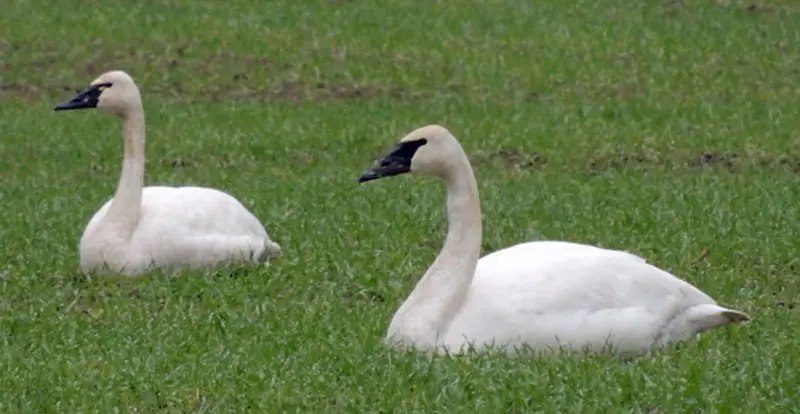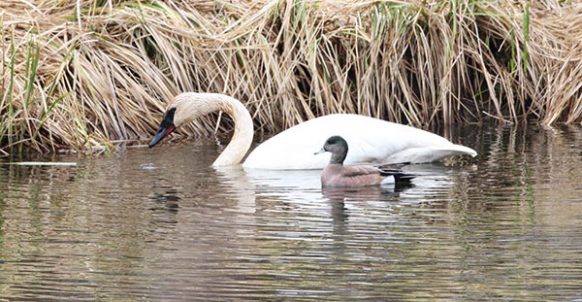Our programs and initiatives are dedicated to the preservation and protection of the Trumpeter and Tundra swans. Use this page to get more information on where to watch the swans, identifying them, and other helpful resources.
Helpful Links
- Where to Watch
- Swan Identification
- Report a Swan
- Threats Facing Swans
- Swan ID Quiz
- Quiz Answers
- Helpful Resources
- Sibley Guide: Trumpeter vs Tundra Swans
- Washington Dept. of Fish & Wildlife – Trumpeter Swan
- Washington Dept. of Fish & Wildlife – Tundra Swan
Where To Watch

Skagit Valley Viewing - Skagit County
The Skagit Valley supports the largest concentration of wintering Trumpeter Swans in North America as well as thousands of Tundra Swans. The swans are present from early November through mid-March. The best time of the year is late December through February. There are many places in the general Skagit Valley agricultural fields for viewing. As you drive around please be aware of parking limitations on the side of the road in some areas. Take a drive around Fir Island and then out through the main valley floor to see mixed flocks of Trumpeter and Tundra swans as they feed on post-harvest potatoes, corn as well as pasture grass and/or winter wheat/rye fields. Take various roads as they will lead you to the flocks as they move around the valley to various places during the winter.

Johnson-DeBay Swan Reserve - Skagit County
This site was created by a public/private partnership in 2001. Its primary purpose is to provide quality public viewing of swans during their winter stay. It is owned and managed by the Washington Department of Fish and Wildlife (WDFW) as part of their Skagit Wildlife Area.
A Discover Pass is REQUIRED to park in all improved parking areas on WDFW lands. You can purchase this permit at any store that sells hunting and fishing licenses or on-line WDFW or State Parks. For a list of vendors in this area visit: https://wdfw.wa.gov/licenses/parking
PETS MUST REMAIN IN THE VEHICLE
Open Hours:
About 8:00 A.M. until dusk.
The Reserve is open to the public every day. Please remember that even if the gates are closed you may still park in the outer lot and walk around the gate to bird watch within the Reserve.
The past few years the swans have been moving about and can be found in the Reserve and in the surrounding fields adjacent to the Reserve. You may see hundreds of Trumpeter Swans, a few Tundra Swans, Canada Geese, and thousands of ducks of several species including Mallards and Pintails. Bald Eagles, Northern Harriers and Cooper’s Hawks are common raptors and many other bird species are possible during this time of year.
Crops Planted: Crops Planted The site is usually planted in corn or potatoes depending on the rotational cropping plan. The past two years, the site has been undergoing soil restoration and about one-half of the Reserve is planted in alfalfa. This improves soil condition as well as restoring important nutrients lost with continuous plantings of corn or potatoes.
The current cropping plan is to harvest the corn or potatoes and over-seed with winter wheat. The waste crop left in the field is highly attractive to swans and the winter wheat provides additional winter forage for the birds. Some corn is left standing, then knocked down in late January after hunting season to provide an additional food resource.
Gate: If the gate is locked, please park in the outer lot and walk in to the Reserve. The Reserve is open all year, but the gate may be closed. It is opened by volunteers only during the swan season. The reason for the gate to be opened and closed daily is to prevent garbage dumping and vandalism at the site. This on-going problem has been greatly reduced by gate closure at night. You may want to bring binoculars or a spotting scope, and wear warm clothing. Photographic opportunities are often spectacular at this area, especially during swan season.
Bob Heirman Wildlife Park at Thomas’ Eddy – Snohomish County
The 340-acre Bob Heirman Wildlife Park at Thomas’ Eddy is one of the best places in Snohomish County for bird-watching, harboring wintering Trumpeter Swans and a few Tundra Swans and as well as ducks, geese and other water birds. It is a Snohomish County Park.
From the trailhead, follow an old road that now serves as the preserve’s central trail down a short but steep bluff to check out both Robins Pond and Shadow Lake out on the floodplain area at the bottom of the bluff. During the winter months Shadow Lake is a major night roost for Trumpeter Swans and a few Tundra Swans especially in late November through December. The best time to see swans is about an hour before sunset and again in the early morning hours. The spectacle of hundreds of swans flying into and then out of this night roost is amazing. Optics and a camera are recommended.
Please Note: Dogs are prohibited. This is a wildlife preserve.

Kent – Sumner – Puyallup Area – Southwest King County/North Pierce County
This is a general area to drive. Swans, mostly Trumpeters, may be anywhere in this geographic area throughout the late fall/winter to late winter season. They will be in the agricultural fields, corn mazes, and sometimes on ponds or flooded areas. Check out eBird for the recent sightings in this area.
For more exact locations, look up the following using Google Maps.
Know spots for swans: Kent Ponds (officially titled the Green River Natural Resources Area).
Maris Farms–East of Lake Tapps on Sumner Buckley Hwy and Buckley Tapps Hwy E.
Spooner Farm corn maze–96th St E and Hwy 162.
Fields south of Sumner off SR 410, going south on Riverside Rd E. Look around in fields, then go east on 86th St E almost to the end–swans often seen here in good numbers.
Sequim Area - Clallam County
Ridgefield National Wildlife Refuge - Clark County
Chehalis Valley-Elma Area - Grays Harbor County
Woodland Bottoms Area – Cowlitz County
Just across the Columbia River and just north of Sauvie Island, Oregon also a good place to view waterfowl and sometimes swans.
Eastern Washington
Turnbull National Wildlife Refuge - Spokane County
Columbia National Wildlife Refuge - Grant and Adams Counties
Calispell Lake, Usk-Cusick Area – Pend Oreille County
Report A Swan
Your observations will help provide essential information needed to increase the long-term security of Trumpeter and Tundra Swans in Washington State and the Pacific Northwest.

eBird Online Trumpeter Tundra Swan Maps
Find out where Trumpeter and Tundra Swans have been seen and reported to eBird. These online maps zoom in and out for Washington State and across North America. Zoom in to find the dates and locations of swan sightings near you!
PLEASE NOTE: If you are not already an eBird contributor, you will see a sign in/up page from Cornell Lab Account. Please sign up for a FREE account with Cornell Lab and you will have access to all eBird maps and information and be able to submit your sightings of swans and other birds. Once signed in, the link will work automatically.
Please Consider Donating
We encourage donations from anyone who wishes to support our mission and goals. We would love to keep these swans gracing our skies and wetlands and any amount would gladly help us continue our purpose.

Download Resources
Download Swan ID Brochure
Read an Article About the Rare Color Variations of the Trumpeter Swan
Photo Gallery for Practice

Photo 1: two Swans, who is who?

Photo 2: who do we have here?

Photo 3: which Swans are these?

Photo 4: this mid-november family is just coming into the wintering area. Are they Trumpeter or Tundra Swans?

Photo 5: which Swans are enjoying the winter wheat grass?

Photo 6: flying Swans are more of a challenge to id. These have all the clues you need. And what age are they?

Photo 7: typical scene in the skagit valley corn fields in january. Can you spot the odd Swan out and what else?
Answers
An Online Test for Those Who Want Additional Skill Building Experience
The Utah Division of Wildlife Resources has an online Swan Hunter Orientation Course. While this test is designed to assist hunters in identifying swans in Utah, much of the information is useful for other areas of the country and birders.
Try it out, you do not have to give any personal information, just skip over the login and other stuff and go directly to the test. You do have to set up a sign in. They will not share your information or send you anything. It is a good test for skill building.
Helpful Resources
This page is a work in progress and new resources will be posted so you can continue to hone our skills.
Learn more about swans around the world.
- Sibley Guide to Distinguishing Trumpeter and Tundra Swans
- Washington Dept. of Fish & Wildlife - Trumpeter Swan
- Washington Dept. of Fish & Wildlife - Tundra Swan





